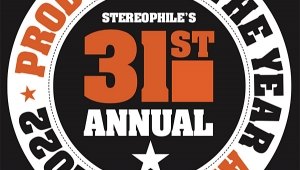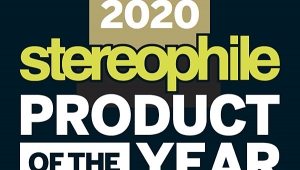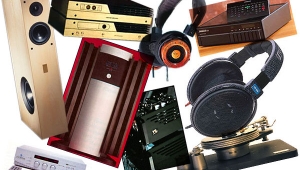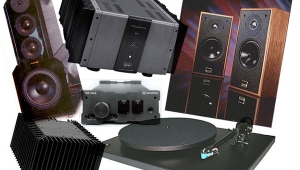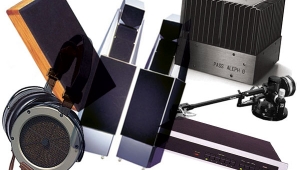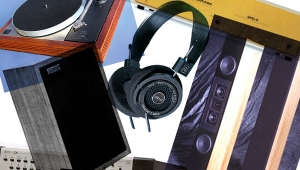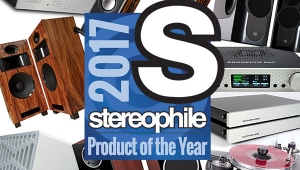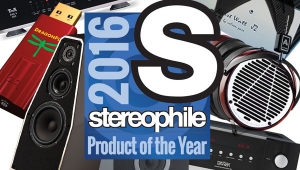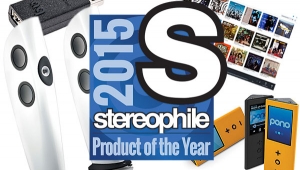| Columns Retired Columns & Blogs |
40 years of Stereophile: The Hot 100 Products
 "Most important." That was the phrase I used when I e-mailed the members of Stereophile's extended family of reviewers and writers to ask for suggestions when I began to compile this list. I didn't want to be more specific because I wanted to cast the net as wide as possible. But there are many factors that make an audio component "important": design innovation, sound quality, sales figures, influence on other designers, influence on the evolving market, influence on system synergy.
"Most important." That was the phrase I used when I e-mailed the members of Stereophile's extended family of reviewers and writers to ask for suggestions when I began to compile this list. I didn't want to be more specific because I wanted to cast the net as wide as possible. But there are many factors that make an audio component "important": design innovation, sound quality, sales figures, influence on other designers, influence on the evolving market, influence on system synergy. When I received everyone's suggestions—thanks, guys, I'm in your debt big-time—I reduced the number of contenders to just 100 and ranked the products from 100 to 1, trying to take all the above factors into account, as well as the impact each component had had on my own development as an audiophile. That a component was undoubtedly the best-sounding had to be weighed against how many people would have actually heard it, for example.
The ranking is therefore intensely subjective—I fully acknowledge that no one else would come up with the same list in the same order. There are also products that are not on the list, despite being important in their ways: the Decca cartridges, for example, or the original Infinity switch-mode amplifier or the Spectral amplifier. Entire technologies have been omitted—the optical disc, HDCD, DSD encoding, 24-bit/192kHz PCM, NXT, room acoustics products, sigma-delta A/D and D/A conversion—and each of these has or will have a profound effect on how we experience recorded music. Japan, Germany, and Italy are under-represented, and France is not represented at all! And, to my shame, there is nothing on the list designed by Tim de Paravicini, David Berning, or Keith Johnson, possibly the three most original, most creative electronics designers who have been working during the 40 years Stereophile has been in existence. Mea culpa.
Any factual errors are mine alone. If you disagree with my rankings or feel important products have been omitted, write me with your suggestions. Where Stereophile reviewed the product, I have listed the issues where the reviews appeared, along with the date of the first one published.—John Atkinson
The List (in ascending order)
[100]: Polk Cobra Cable loudspeaker cable
Stereophile review: 1978 (Vol.4 No.3). Highly capacitive, this distinctive-looking Japanese-sourced cable blew up many amplifiers that weren't unconditionally stable. Nevertheless, it blazed a trail followed first by Bob Fulton, then by Monster, then by countless others.
[98] (tie): Advent 201 & Nakamichi Dragon cassette decks
Stereophile reviews: Advent, Spring 1973 (Vol.3 No.4); Nakamichi, November 1984 (Vol.7 No.6). Henry Kloss's first attempt to wring high-fidelity performance from a format introduced (as a dictation medium!) a year after Stereophile's debut was the Advent 200, which combined Dolby-B noise reduction with a Nakamichi transport. But it wasn't until Kloss replaced the Nakamichi with an industrial mechanism from 3M's Wollensak division, to make the Model 201, that he was satisfied. The rest is history, culminating in Nakamichi's own Dragon. As so often is the case, this ultimate statement in the medium was introduced just a few years before the medium's own death knell was sounded. In the case of the cassette, it was sounded by the digital DAT.
[97]: AR 3A loudspeaker
(No Stereophile review.) It may have been ugly, colored, and with rolled-off highs, but the sealed-box 3A defined the "Boston Sound" and helped establish the American speaker industry. I never liked it, but I can't ignore it. Pretty much the same drive-units were used in AR's multidirectional LST, which years later was to inspire Mark Levinson's Cello speakers. I really didn't like the LST.
[96]: Crown DC300A power amplifier
Stereophile review: Autumn 1968 (Vol.2 No.10). In hindsight, the Crown sounded like early solid-state. But it was powerful, bombproof, and drove the early days of the progressive rock revolution and what was to become high-end audio.
[95]: Magnum Dynalab FT-101A FM tuner
First Stereophile review: August 1985 (Vol.8 No.4; also Vol.10 No.3, Vol.13 No.10, Vol.17 No.10). Magnum Dynalab's more recent MD-108 was the best-sounding FM tuner to come from this Canadian company, but the FT-101A was the tuner that redefined the genre by sticking with analog tuning in a digital world.
[93] (tie): Nagra IV-S & ReVox A77 open-reel analog tape recorders
First Stereophile reviews: Nagra, December 1964 (Vol.1 No.9); ReVox, Autumn 1968 (Vol.2 No.10; also Vol.2 No.12, Vol.3 No.5). The superbly Swiss and superb-sounding Nagra IV-S is in some ways the ultimate analog recorder and is still in widespread use in Hollywood a half-century after Stefan Kudelski launched the first Nagra. The ReVox was made just over the Swiss-German border, in the Black Forest. While its solid-state electronics did not sound as good as the tubes of the preceding G-36, its tape-handling and control ergonomics were to die for, once the scrape flutter had been minimized. The phenolic-paper circuit boards of my Mk.IV are gradually crumbling into dust, but during its lifetime probably more music was recorded on the A-77 than on any other machine.
[92]: Dahlquist DQ-10 loudspeaker
Stereophile review: Winter 1973 (Vol.3 No.7). The Brits hated the DQ-10 for its superficial resemblance to their beloved Quad electrostatic. But with the first Magnepan and the Infinity Servo-Statik, Jon Dahlquist's staggered-baffle speaker helped launch the High End in the early 1970s.
[91]: Yamaha NS1000 loudspeaker
Stereophile review: Winter 1975 (Vol.3 No.11). Back in the days when paper cones were de rigueur (though a handful of British engineers were playing with plastic cones) and designers were starting down the path to trade off reduced coloration against the need for more and more driving volts from the amp, Yamaha introduced the NS1000. It was sensitive, it used a high-tech midrange dome using vapor-deposited beryllium on an aluminum substrate, and it (ahem) kicked major booty! The Yamaha's major use of technology made many contemporary European and American speaker-makers look more like box-stuffers. I haven't heard an NS1000 in 20 years, and often wonder how it would measure up in today's more refined market.
- Log in or register to post comments

